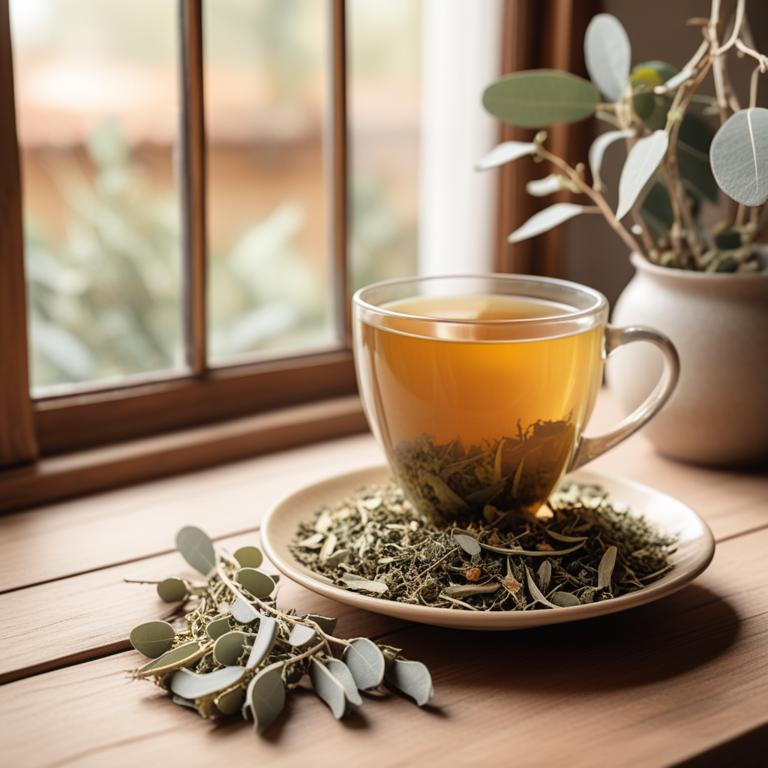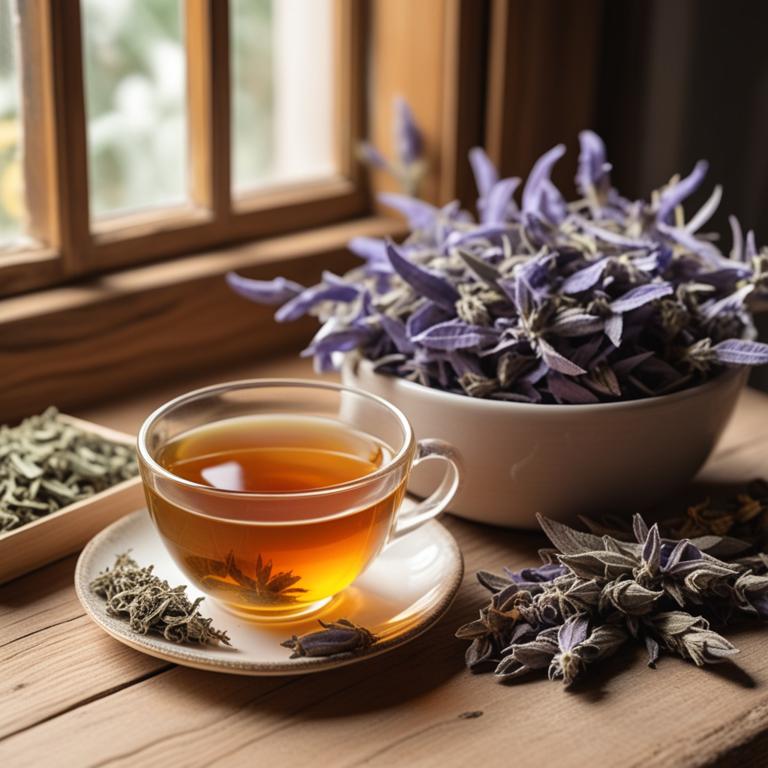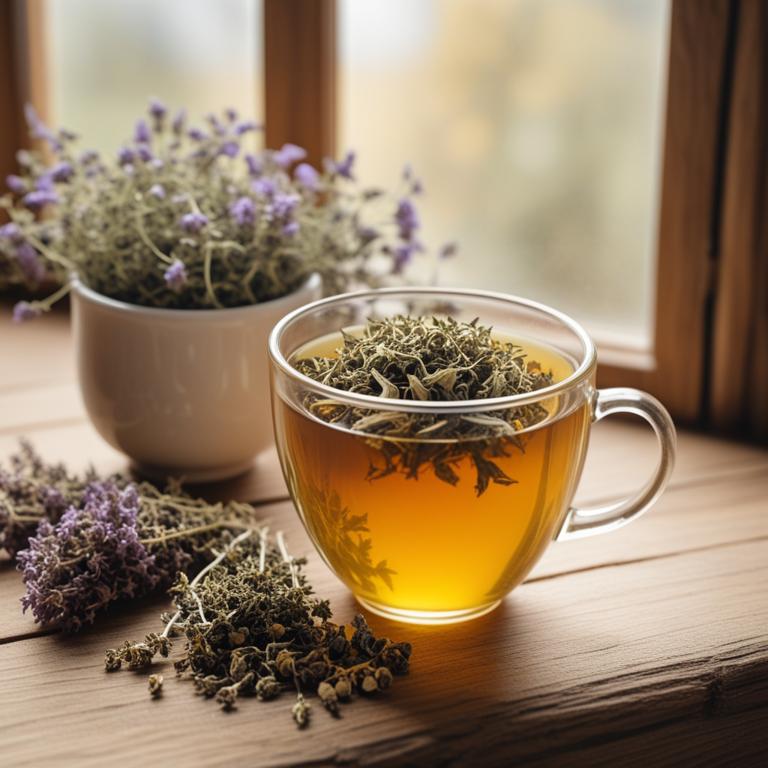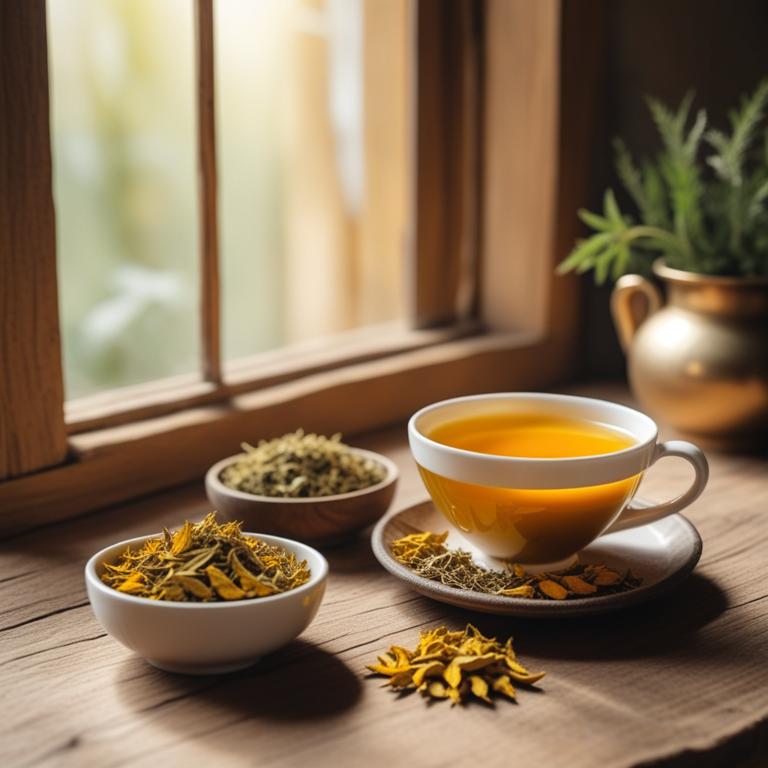7 Best Herbal Teas For Dental Plaque

Herbal teas for dental plaque are a type of herbal remedy that aims to reduce the accumulation of plaque, a sticky film of bacteria, on teeth, ultimately preventing conditions such as gingivitis and periodontitis.
These teas can treat dental plaque due to their antibacterial and anti-inflammatory properties, which help to kill bacteria and reduce inflammation in the gums.
Examples of herbal teas that can be used to treat dental plaque include peppermint tea, which has antibacterial properties that help to kill bacteria that cause plaque, and chamomile tea, which has anti-inflammatory properties that help to soothe and calm the gums.
Other herbal teas that can be used to treat dental plaque include sage tea, which has antibacterial properties that help to reduce the growth of bacteria that cause plaque, and eucalyptus tea, which has decongestant properties that help to reduce swelling in the gums.
Related Study
According to "International journal of molecular sciences", teas for dental plaque contain polyphenols that can reduce the growth of cariogenic bacteria and decrease the adherence of bacteria to the tooth surface.
Below there's a list of the 7 best herbal teas for dental plaque.
Table of Contents
Also, you may be interested in...
Today Free Bonus!
The Ultimate Herb Drying Checklist
(For Long-Lasting Powerful Medicinal Effect)
How to easily dry herbs that don't mold and that keep their strong medicinal power for more than 1 year.
1. Eucalyptus globulus teas

Eucalyptus globulus teas have been traditionally used as a natural remedy to treat dental plaque, a common oral health issue characterized by the accumulation of bacteria and food particles on teeth.
The antimicrobial and anti-inflammatory properties of this herbal preparation help to treat this ailment by inhibiting the growth of bacteria and reducing inflammation in the mouth.
The bioactive constituents, including eucalyptol, limonene, and α-pinene, exhibit potent antimicrobial activity, making them effective in reducing plaque formation and preventing gingivitis.
Regular consumption of Eucalyptus globulus teas has been shown to have several benefits, including reduced plaque and gingivitis, fresh breath, and a healthier oral microbiome.
Related Study
According to the Journal of oral science, Eucalyptus globulus extract-containing chewing gum significantly reduced dental plaque formation compared to the control gum.
Recipe:
- Gather 1 tablespoon of dried Eucalyptus globulus leaves and 1 cup of boiling water.
- Steep the leaves in the boiling water for 5-7 minutes.
- Strain the mixture into a cup using a tea strainer or cheesecloth.
- Add honey or sugar to taste, if desired, and mix well.
- Drink the tea 2-3 times a day to help reduce dental plaque.
Eucalyptus globulus teas can be an effective herbal remedy for treating dental plaque, but it may cause side effects such as allergic reactions, nausea, and dizziness in some individuals.
To use Eucalyptus globulus teas safely, take the recommended dosage and do not consume it for an extended period, as prolonged use may lead to stomach upset and interact with other medications.
Eucalyptus Globulus Tea on Amazon
Jovvily Eucalyptus Leaves - 1lb - Dried - Cut & Sifted - Herbal Tea
Disclaimer: We earn a commission if you click this link and make a purchase at no additional cost to you.
2. Echinacea purpurea teas

Echinacea purpurea teas have been traditionally used to treat dental plaque, a bacterial infection that can lead to gum inflammation and other oral health issues.
The anti-inflammatory and antimicrobial properties of this herbal preparation help to treat this ailment by reducing inflammation and killing bacteria that cause plaque.
The bioactive constituents of Echinacea purpurea teas, including alkylamides, caffeic acid, and rosmarinic acid, are responsible for its therapeutic effects, which help to prevent the growth of bacteria that cause plaque.
The benefits of using Echinacea purpurea teas to treat dental plaque include reduced inflammation, prevention of bacterial growth, and improved overall oral health.
Recipe:
- Gather 1 cup of fresh or dried Echinacea purpurea flowers.
- Use 1 cup of boiling water to make a tea.
- Add 1-2 tablespoons of Echinacea purpurea flowers to the boiling water.
- Steep for 5-7 minutes, then strain the tea.
- Drink 1 cup of tea, 2-3 times a day to help reduce dental plaque.
Echinacea purpurea teas can be used to treat dental plaque, but it may cause side effects such as allergic reactions, stomach upset, and interactions with blood thinners, which can lead to bleeding gums or other complications.
To use Echinacea purpurea teas safely, take precautions such as starting with small doses, avoiding use during pregnancy or breastfeeding, and being cautious when combining with other medications, especially blood thinners and immunosuppressants.
Echinacea Purpurea Tea on Amazon
BLUE TEA - Chamomile Tea - Butterfly Pea Flower -18 Count - Pyramid Tea Bag | DETOX TEA | Caffeine Free - Flower Based - Vegan - Non-Bitter - Natural Ingredients | Tin Packaging
Disclaimer: We earn a commission if you click this link and make a purchase at no additional cost to you.
3. Salvia officinalis teas

Salvia officinalis teas have been traditionally used to treat dental plaque, a bacterial accumulation on teeth that can lead to various oral health issues.
The antibacterial properties of Salvia officinalis teas, attributed to its bioactive constituents such as rosmarinic acid and carnosic acid, help to inhibit the growth of bacteria that contribute to dental plaque.
By reducing bacterial load and inflammation, Salvia officinalis teas help to treat dental plaque, thereby preventing conditions like gingivitis and periodontitis.
The benefits of using Salvia officinalis teas for this purpose include reduced risk of oral infections, fresher breath, and a healthier oral environment.
Related Study
According to "Avicenna journal of phytomedicine", Salvia officinalis teas for dental plaque show significant effects in decomposing tooth biofilm in 45 seconds and inhibiting oral bacteria biofilm formation.
Recipe:
- Gather 1 cup of fresh Salvia officinalis leaves and 1 cup of boiling water.
- Steep the leaves in boiling water for 5-7 minutes, then strain them.
- Get a cup and add 1 tablespoon of honey (optional) to the tea.
- Drink the tea after it has cooled down a bit, ideally 2-3 times a day.
- For best results, use this tea regularly to see improvement in dental plaque.
Salvia officinalis teas can be used to treat dental plaque due to its antibacterial properties, but possible side effects may include gastrointestinal upset, allergic reactions, and interactions with certain medications such as blood thinners and diabetes medications.
To use Salvia officinalis teas safely, take precautions like starting with small amounts, avoiding consumption with other herbal preparations or medications, and being cautious when consuming it in large quantities, especially if you have a history of stomach problems.
Salvia Officinalis Tea on Amazon
Organic India Tulsi Sweet Rose Herbal Tea - Holy Basil Leaf, African Basil, Chamomilie, Lemon Myrtle, Stress Relieving, Immune Support, USDA Certified Organic, Caffeine-Free - 18 Infusion Bags, 6 Pack
Disclaimer: We earn a commission if you click this link and make a purchase at no additional cost to you.
4. Rosmarinus officinalis teas

Rosmarinus officinalis teas have been traditionally used to treat dental plaque, a common oral health issue characterized by the accumulation of bacteria and food particles on the teeth.
The herbal preparation's antimicrobial and anti-inflammatory properties help to treat this ailment by inhibiting the growth of bacteria and reducing inflammation in the gums.
The bioactive constituents of Rosmarinus officinalis teas, including carnosic acid and rosmarinic acid, contribute to its efficacy in treating dental plaque by exhibiting potent antibacterial and antioxidant activities.
Regular consumption of Rosmarinus officinalis teas may help to prevent dental plaque formation, reduce the risk of gum disease, and promote overall oral health.
Related Study
According to "PloS one", Rosmarinus officinalis teas for dental plaque showed moderate to high antibiofilm activity comparable to that of chlorhexidine (CHX) against Streptococcus mutans, with inhibition of biofilm formation at 1.25 mg ml-1.
Recipe:
- Gather 2 tablespoons of dried Rosmarinus officinalis leaves.
- Boil 1 cup of water in a pot.
- Steep the dried Rosmarinus officinalis leaves in the boiling water for 5-7 minutes.
- Strain the liquid into a cup and discard the leaves.
- Drink the tea 2-3 times a day for dental plaque prevention.
Rosmarinus officinalis teas can be used to treat dental plaque, but may cause side effects such as gastrointestinal upset, nausea, and allergic reactions in some individuals.
To use Rosmarinus officinalis teas safely, it is recommended to start with small doses, avoid taking it in large quantities, and be cautious when consuming it with other medications, especially blood thinners.
Rosmarinus Officinalis Tea on Amazon
Palm Beach Medicinal Herbs - Rosemary Tea - Pure Herbal Tea Series, 30ct
Disclaimer: We earn a commission if you click this link and make a purchase at no additional cost to you.
5. Thymus vulgaris teas

Thymus vulgaris teas, derived from the leaves of the thyme plant, have been traditionally used to treat dental plaque, a common oral health issue characterized by the accumulation of bacteria and food particles on teeth.
The antiseptic and antibacterial properties of thyme tea, primarily attributed to its bioactive constituents like thymol, carvacrol, and rosmarinic acid, help to inhibit the growth of bacteria and fungi responsible for dental plaque.
Thymus vulgaris teas work by reducing the formation of dental biofilm, preventing the adhesion of bacteria to tooth surfaces, and promoting oral hygiene, ultimately leading to the reduction and prevention of dental plaque.
The benefits of using thymus vulgaris teas to treat dental plaque include reduced inflammation, fresher breath, and a lower risk of developing periodontal diseases, making it a natural and effective alternative to conventional oral care products.
Related Study
According to "Antioxidants (Basel, Switzerland)", Thymus vulgaris teas have been shown to inhibit the growth of oral pathogens and reduce the formation of dental plaque.
Recipe:
- Gather 1 cup of boiling water and 1 tablespoon of dried Thymus vulgaris leaves.
- Measure 1 tablespoon of dried Thymus vulgaris leaves and add it to a tea infuser.
- Pour 1 cup of boiling water over the tea infuser and let it steep for 5-7 minutes.
- Strain the tea into a cup and discard the leaves. Let it cool down.
- Drink the Thymus vulgaris tea 2-3 times a day to help reduce dental plaque.
Thymus vulgaris teas can be used to treat dental plaque, but possible side effects include gastrointestinal issues such as diarrhea, nausea, and stomach upset due to the volatile compounds present in the herb.
To minimize potential side effects, it is recommended to consume Thymus vulgaris teas in moderation, avoid mixing it with other medications or herbal preparations, and monitor your body's response to the treatment, especially if you have sensitive stomach or allergies.
Thymus Vulgaris Tea on Amazon
Buddha Teas Organic Thyme Leaf Tea - OU Kosher, USDA Organic, CCOF Organic, 18 Bleach-Free Tea Bags
Disclaimer: We earn a commission if you click this link and make a purchase at no additional cost to you.
6. Zingiber officinale teas

Zingiber officinale teas have been traditionally used to treat dental plaque, a bacterial infection that causes inflammation and pain in the gums.
The antibacterial and anti-inflammatory properties of this herbal preparation help to treat this ailment by reducing the growth of bacteria and soothing the inflammation.
The bioactive constituents of Zingiber officinale, including gingerols and shogaols, exhibit potent antimicrobial and anti-inflammatory activities that contribute to its therapeutic effects.
The benefits of using Zingiber officinale teas to treat dental plaque include reduced inflammation, prevention of bacterial growth, and promotion of overall oral health.
Related Study
According to "Journal of clinical and diagnostic research : JCDR", Zingiber officinale teas, which is derived from ginger, exhibited an antimicrobial efficacy of 25mm against oral microorganisms causing caries, making it a potential natural product for preventing dental plaque.
Recipe:
- Boil 1 cup of water in a pot.
- Grate 1-2 teaspoons of Zingiber officinale (ginger) root.
- Add grated ginger to the boiling water and let it steep for 5 minutes.
- Strain the tea into a cup and discard the ginger.
- Drink the tea while it's warm, 2-3 times a day for dental plaque prevention.
Zingiber officinale teas can be an effective herbal remedy for treating dental plaque, but it may cause side effects such as stomach upset, nausea, and diarrhea due to its high ginger content, which can also interact with blood thinners and exacerbate bleeding disorders.
To use Zingiber officinale teas safely, individuals should start with small doses, avoid consuming it on an empty stomach, and be cautious when combining it with other medications, especially anticoagulants and anti-inflammatory drugs, to minimize potential adverse reactions.
Zingiber Officinale Tea on Amazon
FGO Organic Ginger Tea, 100 Count, Eco-Conscious Tea Bags, Caffeine Free, Packaging May Vary (Pack of 1)
Disclaimer: We earn a commission if you click this link and make a purchase at no additional cost to you.
7. Curcuma longa teas

Curcuma longa teas have been traditionally used to treat dental plaque, a condition characterized by the accumulation of bacteria and food particles on the teeth.
The anti-inflammatory and antimicrobial properties of this herbal preparation help to treat this ailment by reducing the growth of bacteria and preventing the formation of dental plaque.
The bioactive constituents of Curcuma longa teas, including curcumin and demethoxycurcumin, exhibit potent antimicrobial activity, which helps to inhibit the growth of bacteria and prevent the development of dental plaque.
The benefits of using Curcuma longa teas to treat dental plaque include reduced inflammation, improved oral health, and prevention of various oral diseases, making it a promising natural remedy for this common oral health issue.
Related Study
According to the study, Curcuma longa teas for dental plaque may be effective due to its anti-inflammatory and antioxidant properties, which help in preventing plaque and calculus formation by maintaining acid-alkali balance in saliva.
Recipe:
- Gather 1 teaspoon of dried turmeric root (Curcuma longa) and 1 cup of water.
- Boil the water in a pot and let it cool for 5 minutes.
- Add the turmeric root to the cooled water and let it steep for 10-15 minutes.
- Strain the mixture through a fine-mesh sieve into a cup and discard the solids.
- Drink the turmeric tea 2-3 times a day for 1 week to help reduce dental plaque.
Curcuma longa teas can be used to treat dental plaque, but possible side effects may include digestive issues, such as nausea and diarrhea, due to its high concentration of curcumin, which can irritate the stomach lining.
To use Curcuma longa teas effectively and safely, it's essential to consume them in moderation, avoid taking them on an empty stomach, and consider diluting the tea with water to minimize potential gastrointestinal discomfort.
Curcuma Longa Tea on Amazon
Pure Ceylon Turmeric Brew - 100% Organic Ceylon Turmeric Tea Bags (40 Sachets - pack of 2 – 20 COUNT PER BOX)
Disclaimer: We earn a commission if you click this link and make a purchase at no additional cost to you.